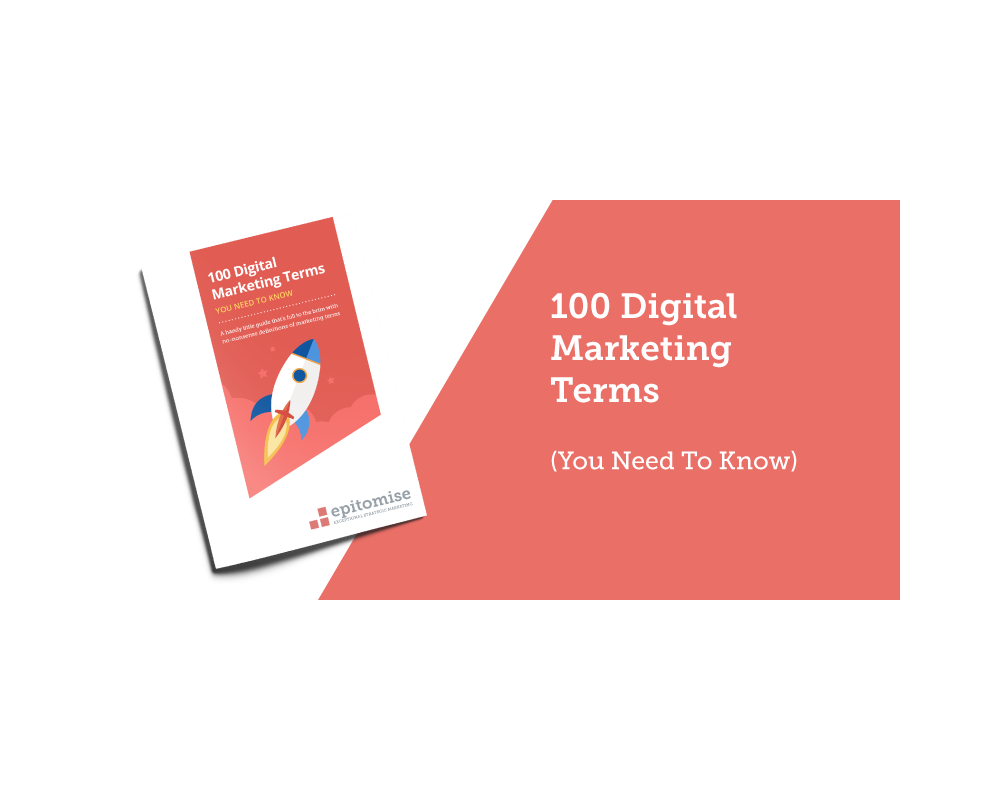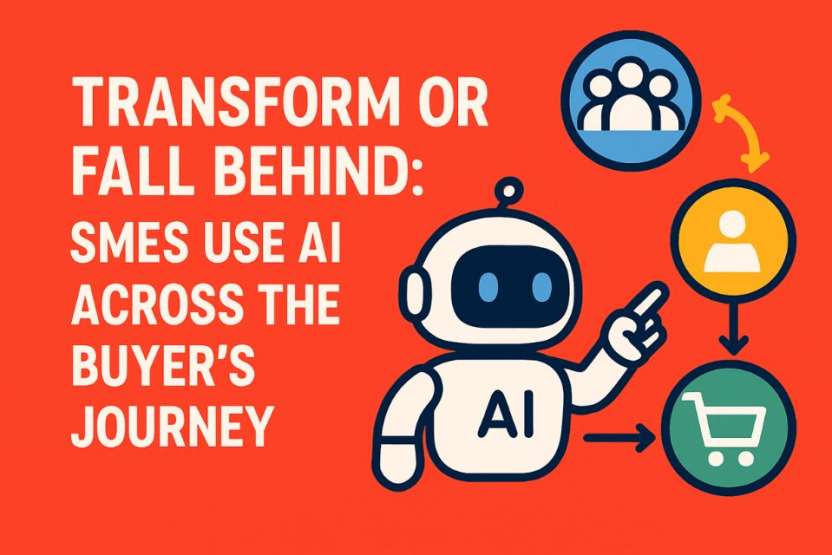Digital Marketing Definitions / Terms (You Need to Know) - 100 Terms
When it comes to jargon, the world of digital marketing is a minefield. It seems as though every other word is some sort of technical term, which can make understanding what’s going on pretty difficult – especially for newbies! But, even old-timers who have been in the business for years and years can struggle to remember what absolutely everything means, especially as the industry evolves so quickly.
That’s exactly why our team here at Epitomise have put together this handy little guide that’s full to the brim with no-nonsense definitions of marketing terms that you need to know. Bookmark it, print it out, or take a mental photo – whatever works best for you! But just make sure you always have it on hand for when you need it. Trust us, in the marketing industry this will be invaluable.

Click to: Download your PDF copy of the Guide
1. Google Algorithm – This is the process that Google uses to make sure that the results that pop up in their engine are relevant to what the user’s asked. Although it’s all kept tightly under wraps, there’s thought to be over 200 different factors that go into Google’s algorithm! This is what makes their results so spot-on.
2. SEO – Also known as ‘Search Engine Optimization’, you’ve probably heard this word chucked about if you’ve ever looked into digital marketing. It’s basically the idea of using what we know about Google’s ranking algorithms to make our own websites rank higher in relevant search results.
3. Keywords – Keywords are used on your website to help you connect with your target audience. They’re terms that are specific to your business and that your potential customers can use to find you. They’re a huge part of SEO, so they’re essential to your digital marketing!
4. LSI Keywords – You have your regular keywords when carrying out SEO – these are the ones that are directly related to what your audience is searching for – and then, you have your LSI keywords, which stands for ‘Latent Semantic Indexing’. By including these in your site’s content, search engines can find the relationships between your terms and concepts, which can boost your SEO and drive traffic.
5. SERP – Put in the simplest of terms, this stands for ‘Search Engine Results Page’, and that's just what it is! It’s the page of results you see when you type a query into a search engine.
6. SEM- Not to be confused with SEO, this stands for ‘Search Engine Marketing’. SEO does come under its umbrella, but it also includes every way that a business uses search engines to market, including PPC and social media marketing.
7. Impressions – When someone views your ad or a post on social media, it will usually be recorded as an impression. So, the more impressions you get, the better your ad or post is doing.
8. Conversion – If a user follows a businesses' leads and ends up following-through with the action that’s been encouraged, whether that’s filling out a form or making a purchase, this is known as a conversion. They’re literally being converted from a user to a customer – makes sense, right?
9. Conversion rate – A businesses conversion rate is basically the percentage of people who become paying customers after interacting with a piece of marketing, such as an ad. The higher the conversion rate, the happier a business will be!
10. Breadcrumbs – Based on the great idea from Hansel and Gretel, but executed just a little better, breadcrumbs are a way to help users navigate around the site. They really help to improve a sites usability, as well as boosting SEO. They create a logical path of where’s been visited, and where the user is in terms of the site flow.
11. PPC – Also known as ‘Pay Per Click’, this is when businesses get ad space, usually from a search engine, and pay based on how many people click on the ad. In this way, they’re only paying if the ad they’ve created is actually working – you can see why it’s an appealing marketing technique!
12. CPA - ‘Cost Per Action’ is similar to PPC, which makes a whole lot of sense as PPC actually falls under this category. It’s essentially when a business pays for a certain action taken by a potential client; be it clicking on an ad, filling out a form, or making a purchase.
13. CPC – This stands for ‘Cost Per Click’, and it’s how much a business actually pays for each click on their PPC ad. Enough abbreviations yet? There are more coming!
14. CTR – This is the ‘Click Through Rate’, and it’s a great way to measure the success of your ads. To work it out, all you have to do is divide the number of people who clicked on your ad by the number of impressions it got. Simple.
15. ROI – Standing for ‘Return on Investment’, this one pretty much does what it says on the tin. It’s how much money a business will get back from any specific marketing technique or campaign in profit, which can help them to see how well it worked for them.
16. Featured Snippets – If you type a question into Google, you sometimes get a little bit of text that answers your question at the very top of the results – this is a featured snippet.
17. Ad Extensions – From location to phone numbers, these are just extra snippets of information businesses can include in their ads to increase their CTR and add value.
18. Alt text – If a piece of content – usually an image or video – can't be loaded on a webpage, the alt text is what will be shown instead. So, usually, it’s a small piece of descriptive text about what the content shows.
19. Landing Pages – When you type a query into a search engine, you usually get a bunch of website pages that pop up in the results. Each of these website pages is also known as a landing page, because they’re the first place in the website that you’ll ‘land’ on when you follow the link.
20. Advertising Quality Score – This is Google’s method of rating your PPC ads, determining your CPC, and ranking you in the ad auction process. As is Google’s way, they keep this fairly secret by not letting us know just how important each of their ranking factors are, but we do know they base it on your CTR, keywords, landing page quality, history of your AdWords performance, and your ad text relevancy.
21. Keywords Google Signals – By letting you track your users across devices, Google can let you discover more about your active audience. It doesn’t matter what kind of device or platform they’re using, you can see what they’re up to!
22. Predictive Lead Scoring – If your business is getting a whole lot of leads, it doesn’t make sense to follow through with all of them, right? This is when you’ll use the predictive lead scoring algorithm to separate the ‘good leads’ from the ‘bad leads’. Basically, you’ll use a number of factors to make sure the leads you’re following up on are the right audience for your services.
23. Structured Snippets – These are a part of Google Adwords, and can help to entice users to click on your ad if you have something they’re looking for. There’s a little section of your ad where you can write ‘values’, which are meant to help show the specifics of your products and services. So, for example, if you sold coats, your values could be ‘Trench coats, rain coats, fur coats, black coats’.
24. Programmatic Ads – If a business wants to ditch the middle-man and buy ads quickly, they’ll use programmatic advertising. This is when bids are placed automatically and in real-time whilst the page loads, targeting specific customers.
25. Funnel – The marketing funnel is a system that businesses use to take potential customers from the beginning of their interaction with your company right through to the sale. It begins with lead generation, which moves some of your audience into lead nurture, and then the remaining audience move down into sales, which is, of course, where you want them to end up. The funnel can also be explained by TOFU, MOFU, BOFU, which we’ll get into now...
26. TOFU – Standing for ‘Top of the Funnel’, this is the first and widest part of the funnel. It’s when a business's audience is at their widest and most general, and the point when the company is focused on getting themselves noticed.
27. MOFU – This is the ‘Middle of the Funnel’, and is the consideration stage. The audience is more targeted here and the business has their attention. At this point, you could even have a lead!
28. BOFU – You’ve probably got the hang of this by now but, if you haven’t guessed already, BOFU stands for ‘Bottom of the Funnel’. This is decision time, when the business wants to convince their leads to make a purchase.
29. Tracking Code – If a business puts a little bit of code in their header or footer called a tracking code, they can track the data of users who view their site and gather very useful information on their audience and customers.
30. Search advertising – This is the broader term for placing ads on search engine results pages. So, it’s just like Google Adwords, but for all of the search engines!
31. Munchkin Codes – This is a JavaScript tracking code that’s custom-made by Marketo. It tracks users on your website, monitoring traffic and using cookies to record user behaviour. It’s a pretty useful tool to have, and can help you keep in touch with how well your marketing is driving leads.
32. Display advertising – If you’re on a site and see an advert, be it an image at the side of the screen or a video that automatically starts playing, this all comes under the umbrella of display advertising.
33. Content Marketing – Content encompasses a whole lot of marketing materials, including blog posts, images, infographics, and videos – to name just a few! These are then used for marketing, adding value to a business, showing them as an authority in their industry, and helping them to build a trusting relationship with their target audience. Content marketing can also be linked with SEO.
34. Boosted Content – Usually on social media, boosted content is when businesses – or individual people, groups, or pages – pay to have their content pushed up the feeds of their followers, or have them appear on the feeds of people who aren’t following them. It’s a great way to ensure a post doesn’t get lost in the sea of never-ending content.
35. Inbound Marketing – This is a method of marketing which uses methods such as SEO, content marketing, and social media marketing to draw leads into a business. Usually, it’s about adding value and authority to a brand through these methods to gain attention and trust from a targeted audience.
36. Outbound Marketing – Whereas inbound marketing is all about drawing people in, outbound marketing is chasing after potential clients. It’s usually done through more traditional methods, such as email marketing, cold calls, and events.
37. On-Page Optimization – This is the method of increasing your webpages SEO ranking through changes you can make to the actual page. For example, adding keywords, alt text, and including authoritative links.
38. Off-Page Optimization – This is the method of boosting a websites SEO using techniques that don’t change the website, so it’s basically the opposite of on-page. These techniques can include link building from other sites and social media marketing, and when paired with on-page optimization, the two make a very good team!
39. Generation Z – You've heard of millennials, but Generation Z are the next big thing in the marketing world. They’re classed as being born from the mid 90’s to somewhere between 2010 and 2012 (there’s a lot of differing opinions on this one).
40. Lookalike Audiences – A method of reaching a targeted audience by Facebook, Lookalike audiences are, in the simplest of terms, an audience that Facebook pulls together that has similar attributes to another group that you provide. So, you could submit a load of email addresses from your mailing list, and Facebook will find their profiles, and generate another set of users who their algorithms deem to be similar.
41. Lead Generation – When you’re a business, you need people to take an interest in what you’re offering, and that’s where lead generation comes in. Through a whole variety of marketing techniques, you can draw potential customers into your website, attracting their attention and making them interested in what you’re offering. These are leads.
42. Engagement Rate - This is all about content and measuring its success in terms of how many people are interacting with it. It measures likes, comments, shares, and all that good stuff, and divides them by the number of followers or views to get the total rate.
43. B2B and B2C - These are the two types of business transactions; business to business, and business to consumer.
44. CTA - If you go on pretty much any website – or any good one anyway! - you’ll probably be able to spot a CTA, otherwise known as a ‘Call to Action’. This is basically a short piece of text that encourages the site’s users to do something, whether that’s get in touch, head to another web page, or make a purchase; whatever the business wants them to do.
45. Buyer Persona - This is a fictional character designed to represent a typical user that would be interested in the business. Companies can then use it to base who they’re marketing to on, making it more targeted towards their kind of audience.
46. Domain Authority - To predict how well a business's page will rank in Google, domain authority is calculated using a range of factors, including inbound and outbound links, the loading speeds of webpages, and how well the website is optimised for a range of devices, including mobile.
47. Bounce Rate - It’s all well and good having a ton of users click onto your website from a search result or other link, but if they leave before having clicked further into your site, this definitely isn’t a good sign. The higher number of people who leave after sitting on only one webpage, the higher your bounce rate.
48. Header Tags - These are your H1, H2, H3 tags, all the way up to H6, and they’re used in code to help structure content. Usually, these create the title (H1) and subheadings on your webpages, and they can boost SEO when used properly.
49. Total Opens - When measuring how many recipients open your emails, total opens is the number of times an email from you is opened, including more than once by the same recipient.
50. Unique Opens – Compared to total opens, unique opens don’t take into account more than one open by the same recipient. So, where you can have 350 total opens, you may actually only have 300 unique opens.
51. Email Open Rate – By dividing the number of either total or unique opens by how many emails you sent, you can work out the email open rate of a campaign.
52. Organic Traffic – Using SEO, businesses try to drive up their organic traffic, which is the number of users who visit a site from search results.
53. Paid Traffic – This is when a business pays for marketing and it brings users to their website, such as from PPC ads.
54. Contextual Marketing - By tracking user behaviour and past searches, contextual marketing can generate ads that are targeted towards their interests rather than completely random.
55. Content Syndication – If you want to push your content out to a wider audience, be it a blog post, article, or any sort of web content, you can get a third-party to republish it. So, it’ll be out there on the world wide web twice, and you’ll also get an SEO boost from backlinks from the third-party to your site. But, isn’t there the problem of duplicate content? Well, yes, but we’ll cover that now...
56. Canonical Tag – This is how SEO savvy marketers get around the problem of duplicate content. Usually, having more than one version of the same thing would mess with your SEO ranking, but the canonical tag lets Google know which version you want to be the ‘master copy’, which is the one that will show up in the search engine results.
57. 301 Redirect – When a business moves website, they need to redirect users from their old URLs to the new web pages with a permanent link, which is the 301 redirect. In this way, they keep the domain authority and SEO from those old webpages, and don’t lose any potential leads.
58. 302 Redirect – This has the same purpose as the 301 redirect, but the link is only temporary.
59. 404 Error – If a webpage is broken or doesn’t exist anymore, the server can’t find it and so instead displays an error page, known as a 404 error. You definitely don’t want these anywhere on your website!
60. LinkedIn SSI score – Your SSI score, otherwise known as ‘Social Selling Index’ is used to show how well you show your professional brand off on their platform, as well as how good you are at finding the right users to connect with, building relationships with them, and engaging with your insights.
61. Anchor text – When incorporating a link into content, this is the actual portion of content that has the link.
62. Broken Link – If a webpage has a 404 error, any links to it will be broken. In the same way, if a link’s URL is misspelled, that link will also be broken!
63. External link – This is when a link points to a URL that’s under a different domain than the website it’s linking from.
64. Link Pyramid – A business can create a sort of path of links to webpages, where the links filter down, providing multiple webpages with a split-share of the original link’s authority, also known as ‘link juice’.
65. Link Profile – This is a detailed analysis of all of a website’s external links, taking into account their quality and authority.
66. Reciprocal Link – If two websites link to each other for mutual benefit, these are known as reciprocal links. Why would you do this? Well, you both benefit in terms of SEO by having more external links pointing to your website, so it’s a win-win, really!
67. CDN – The delivery of web pages to the user can be made much faster by having a whole system of servers, with the user request being sent to the server that can operate for that specific task the best. This is known as ‘Content Delivery System’, and it makes everything much more efficient!
68. CRM – Another abbreviation! This one stands for ‘Customer Relationship Management’, and it’s the process of tracking users’ interactions with a company throughout their journey with them as a means to improve customer service.
69. DNS – ‘Domain Name Servers’ are basically the phonebook of the internet, with a whole directory of domain names which can be translated into IP addresses.
70. IP Address – Good timing! An IP address, which we just mentioned above, is the series of numbers that identifies each and every computer, allowing all the devices on the internet to connect with each other.
71. Downsell – The art of down selling involves offering your potential clients a different service or product after they’re not keen on the first. It can be written into a piece of content, pop up when a user goes to exit a page, or show up in a whole number of other sneaky places!
72. FTP – Also known as ‘File Transfer Protocol’, this is how files are transferred between a server and a user.
73. Marketing Automation – From social media comments to sending out a ton of marketing emails, sometimes the big tasks are better when they’re carried out by high-tech software programmes. This is exactly what marketing automation is. The software and programmes can be set-up to do the work for you, automatically getting the job done – what world we live in!
74. Meta Title – When you see search results in a search engine, the meta title is the header text for each search result. So, for example, if you type Facebook into Google, theirs is ‘Facebook - log in or sign up’.
75. Meta Description – In the same way as the meta title, the meta description is the text shown for search results, but this is beneath the meta title and should contain around 150 characters. It tells users a little more about the business or landing page they’ll be clicking into – very useful!
76. Qualified lead – When a user has shown interest in your products or services and can move further down the funnel, they become known as a qualified lead.
77. Sitemap – This is simply a list of pages on a website that can be used to show the authority or importance of each separate web page in relation to one another.
78. Spider – Also known as a crawler, these automated bots are used by search engines to index web pages.
79. Unique visitor – When recording visitors to a site, a business can track every single time a user is on their page, or every single time only a new user – e.g. an IP address that hasn’t been on their site before – visits. The latter is a unique visitor.
80. User Generated Content – Any content from users on a website is known as user generated content. This could be anything from comments to reviews.
81. Pixel - A pixel can also be called a tag, and it’s a short section of code that tracks users and gathers information from them. This helps businesses monitor how well campaigns are going and sends relevant ads to the right audience. It’s incredibly userful for creating more targeted marketing!
82. UX – Simply standing for ‘User Experience’ this is how pleasant or unpleasant a user finds a website or webpage when browsing it. Of course, every business wants their users to find their website easy to use, so UX is very important.
83. Viral Marketing – As soon as a business is encouraging users to share content from an experience with their brand on the internet, it’s known as viral marketing.
84. List Segmenting – If a business has a mailing list that’s full of lots of potential leads, they can split them up based on different factors to create more targeted campaigns, rather than sending the same marketing to all the email addresses.
85. Churn Rate – This is the calculated percentage of users who unsubscribe to a service, such as a mailing list.
86. Influencer Marketing – This is a really popular marketing method these days, and involves using celebrities and social media users with large followings to promote a business, services, or products. As the name suggests, the social media stars are pretty influential, and if they’re shouting about something, chances are a fair few of their followers are going to want to have it too!
87. Blacklist – If your email marketing is a little too spammy, you’ll be put on this very ominous sounding blacklist, which means your emails are less likely to show up in people’s inboxes.
88. A/B Split Testing – If there are two variations of one marketing campaign with a slight difference, both can be tested with a small control group to find which works better.
89. Keyword Density – This is simply the number of times a keyword is used on a webpage. Usually it’s shown as a percentage that relates to the overall length of the content in comparison to how many times the keyword has been used.
90. Keyword Stuffing – If you want good SEO, this is something you definitely shouldn’t be doing – and something that a lot of businesses do! It’s basically when a whole lot of keywords are forced into written content, making it sound unnatural and usually getting the whole page penalised by Google.
91. Map Pack – This is when Google shows a group of local listings for businesses in a certain location in their search results that are relevant to the user’s query.
92. NAP – Standing for ‘Name, Address, Phone Number’, having consistent NAP information across all of a business's sites and platforms is vital to ranking them well – and from stopping customers from getting confused, too!
93. Schema Markup – This is code that you can include in HTML to help search engine's read a website better and rank it for relevant searches.
94. Slug – It’s not the loveliest sounding term, but this is just the bit of a URL that comes after .com.
95. Wireframe – When a website is being designed, a wireframe is the initial blueprint for how it will look.
96. Cross-Device Targeting – By displaying marketing campaigns across a range of platforms, such as webpages, social media, and apps, you can create a targeted campaign that moves across devices as your audience does.
97. Overlay – Have you ever been watching a video and a little ad pops up over the top of it? It’s usually not very obvious – somewhere towards the bottom of the video – and sometimes has an option to clear it off of your page. This is an overlay ad, and it’s the way marketers have switched from having ads on web pages with written content to the newer and increasingly popular video content.
98. View Through – As soon as a user sees your ad, they can be tracked for a period of time if they don’t convert straight away. If they then later do convert and it can be linked to the ad they saw, this can still count as a conversion. For some businesses, it’s a much better way of recording the success of their marketing.
99. Disruptor – If a company develops a product that changes an industry, they’re known as a disruptor. One of the biggest examples of this is Uber, which completely revolutionised the taxi industry.
100. Dedicated Hosting – This is when an entire, private server is used to host one client’s websites.
There you have it! If you’ve read through all 100 of these then, first of all, good on you, and secondly, you should know now a whole lot about digital marketing now. But, if you’ve got a bit stuck and feel confused by any of these terms, or just need some expert digital marketing advice, get in touch with our team here at Epitomise. We’re always happy to help and share our marketing knowledge with the world, so don’t be shy!

Download your PDF copy of the Guide.
Like this? Share it!
About Epitomise:
We help SME and Technology companies use modern marketing strategies to grow. From strategic advice to tactical execution grow your business with the support of a 'top-100' award-winning marketing leader who is supported by a network of expert marketing specialists. With over 20-years' senior marketing experience and a track record of delivering results, as an attentive expert strategic marketing and services company, we help you grow your brand, leads, sales and customers by doing the right things the right way. Help for as long or as short as you need.






